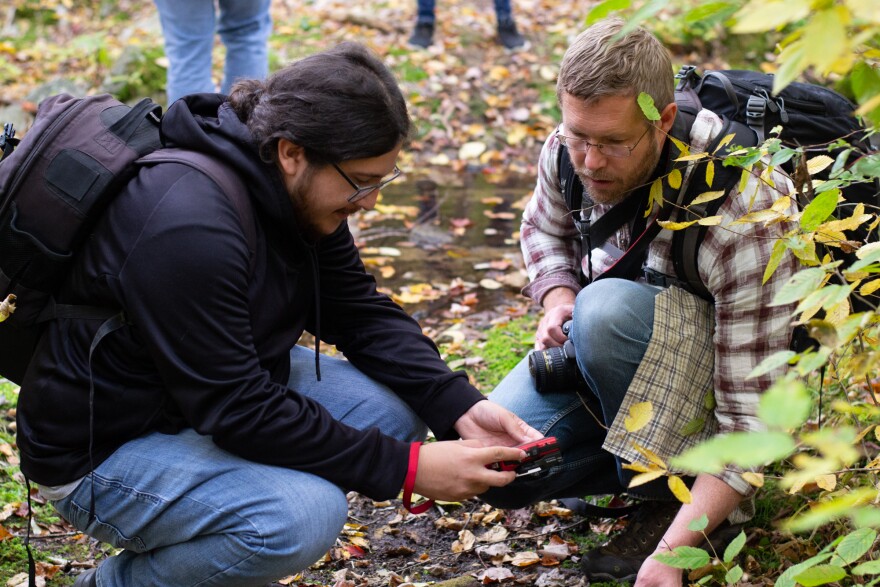A local conservation photography class has been documenting biodiversity on Shenandoah Mountain this semester. WMRA's Randi B. Hagi reports.
On a Wednesday afternoon in October, I caravanned westward with two cars full of photography students – passing Reddish Knob and parking about an hour's drive into the mountains.
[sounds of chatting, car doors closing, group walking]

Eight young adults geared up with cameras, lenses, and bags, and followed Steven David Johnson into the woods. Johnson teaches photography at Eastern Mennonite University in Harrisonburg, and his own groundbreaking work documenting Appalachian wildlife – above and below the water's surface – has been featured in publications including Ranger Rick and the cover of The Nature Conservancy magazine. On this field trip, the students were tasked with documenting plant and animal biodiversity on Shenandoah Mountain – including salamanders.
STEVEN DAVID JOHNSON: You know, if you're looking for salamanders, the big thing when you're looking at cover objects, especially if they're stones – just lift them straight up, look carefully to see if anything's there. If not, you can put it back.
We hiked down a trail strewn with acorns towards a mountain spring that eventually becomes the North River – stopping periodically to take photos, identify tree species, and look under rocks.
[woodland sounds]
JOHNSON: Yeah, if anybody wants to see a different salamander species, these are a kind of streamside salamander. Northern two-lined salamander.
Helping to guide us was Lynn Cameron, cofounder of the Friends of Shenandoah Mountain.
LYNN CAMERON: Is that a baby, or a?
JOHNSON: No, they get a little bit bigger, but that's an adult.
STUDENT: Where is it, Steve?
JOHNSON: Right there. … Eurycea bislineata.

Friends of Shenandoah Mountain – which, for decades, has championed the creation of the Shenandoah Mountain National Scenic Area currently proposed in Congress – is one of several organizations Johnson has partnered with in the nearly 10 years he's taught this class.
The students benefit from the geographical and ecological knowledge of people such as Cameron, and the advocacy groups benefit from the images that the students produce. That's really what makes it conservation photography.
JOHNSON: Some people have described it as putting your photography to work. So rather than just pretty images – you still want them to be aesthetic images, but you also want them to communicate a story and be put in the service of advocacy for the organizations that are working to protect species and landscapes.
CAMERON: One reason we're seeking designation of the Shenandoah Mountain National Scenic Area is to protect the biodiversity that's here, and we're really just learning more about the biodiversity.
When we arrived at the spring, in a little hollow in the woods surrounded by golden leaves, I tried my own hand at finding salamanders.
[shuffling in the leaves]
HAGI: Oh, I found one! … A little salamander, I'm not sure what kind. Maybe the red-backed?

JOHNSON: … Yep! Red-backed. I was checking carefully because sometimes the Allegheny Mountain Duskies can kind of look really similar. But you can tell by looking at the pattern on their back. The duskies have that kind of upside-down V, chevron pattern. [camera shutter sounds] I love it when they do that little curl.
Students Cassidy Walker, Thomas Erickson, and Rebekah Amstutz gathered around to get a few shots, and explained how to 'leave no trace' afterwards.
CASSIDY WALKER: So, after everybody gets their photos, we basically just push him to the side with a leaf or something, and then cover it back up. So I can – [shuffles leaves] … Go buddy, go! Go buddy go! He does not want to move. [laughs]
THOMAS ERICKSON: Now Rebekah's here, so we gotta –
WALKER: Rebekah, get some photos!
REBEKAH AMSTUTZ: Who is our friend?

WALKER: This is a red-backed. And he's being difficult and he doesn't want to leave his bed.
Another partner with this semester's class is the Shenandoah chapter of the Virginia Native Plant Society, which is headed up by Johnson's wife – Anna Maria Johnson. The chapter is working on a native plant guide for gardeners in the ridge and valley region of Virginia, which may end up featuring some of the students' photos.
ANNA MARIA JOHNSON: So, most of what people plant in their yards that they get from big box stores are plants that look really pretty but are not useful for the insects, the pollinators, and our local wildlife. So that's why there's been a push to have more of the traditional, indigenous plants that we expect to have in a healthy ecological system.

Their group shares the common goal of protecting the Shenandoah Mountain region and its many endemic species.
ANNA MARIA JOHNSON: We want to make sure that any development and trail work that's done would … be located in places that are more appropriate, and not be located in places where we have rare species of plants and salamanders that can't really live anywhere else.
Steven David Johnson's students have a track record of producing photographs with real-world impacts – such as documenting the proposed path of the Atlantic Coast Pipeline, which was canned in 2020.
STEVEN DAVID JOHNSON: So Shenandoah Mountain was part of that, because part of the proposed original route would have gone through Cow Knob Salamander territory, and so some of my students were able to locate Cow Knob Salamanders and actually show that they were still there in that proposed path.
It's also an opportunity to just enjoy the natural world. This semester, the students will also learn specialized techniques, such as shooting with underwater equipment and drones.



